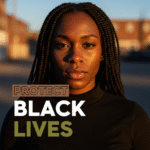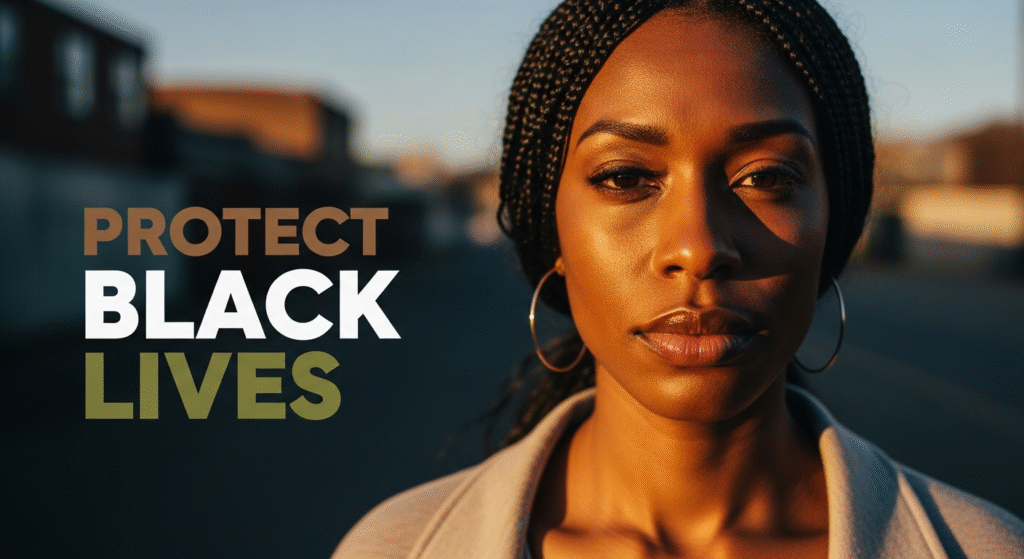

Beyond Remembrance: Protecting Black Trans Lives
By Darius Spearman (africanelements)
Support African Elements at patreon.com/africanelements and hear recent news in a single playlist. Additionally, you can gain early access to ad-free video content.
Every year on November 20th, communities gather for the Transgender Day of Remembrance (TDOR). It is a day born from profound grief, designed to honor the memory of transgender people lost to violence. However, a powerful and necessary conversation is growing within our community. Black trans writers and activists are declaring that remembering our dead is no longer enough. They demand a shift from mourning to action, calling for concrete solutions like housing, safety plans, and policy reform. This is a call to keep Black trans people alive, rather than only reading their names once they are gone (harvard.edu).
This urgent demand is rooted in a deep history of violence and erasure. The struggles of Black transgender people have often been ignored within broader liberation movements. To understand the call to move “beyond remembrance,” we must first understand the history behind the headlines. This means looking at the systemic issues that created this crisis. It is a history that connects the violence of the past to the dangers of the present. Therefore, this is a fight for the future of Black liberation itself.
The Painful Roots of Trans Remembrance
The history of the Transgender Day of Remembrance begins with the loss of Black transgender women. The day was founded in 1999 by Gwendolyn Ann Smith, Nancy Nangeroni, and Jahaira DeAlto to memorialize Rita Hester. She was a Black trans woman murdered in Massachusetts in 1998. The earlier deaths of Chanelle Pickett in 1995 and Monique Thomas in 1998 also fueled the creation of this day. It was a way to shine a light on the brutal, often forgotten violence aimed at our community, especially trans women of color (harvard.edu).
This violence is not new. It has roots that stretch back centuries in America. For instance, nineteenth-century blackface minstrelsy created harmful caricatures. These performances stigmatized Black women, and by extension Black trans women, as both threatening and inauthentic (harvard.edu). They used characters like the “Jezebel” to portray Black women as hypersexual and aggressive, laying a foundation for this prejudice (nih.gov). Individuals who defied gender norms were also ridiculed, reinforcing the idea that their identities were a deceptive performance. Consequently, this painful history has created a lasting cultural narrative that continues to endanger Black trans lives today.
This historical context is critical for understanding the systemic challenges faced by Black trans people. “Systemic” means that these problems are not just isolated incidents of prejudice. Instead, they are embedded in our institutions, laws, and societal structures (nih.gov). Early figures like Mary Jones, an openly transgender person of color in the 19th century, endured extreme violence and isolation in a society that criminalized non-conforming gender expressions (harvard.edu). Gender non-conforming expressions are ways of presenting oneself, through clothing or mannerisms, that challenge traditional gender expectations (nih.gov). The experiences of Black queer individuals, a term for people who are not heterosexual or not cisgender, have consistently been erased from mainstream history.
A heartbreaking example is the story of Frances Thompson. She was a formerly enslaved trans woman who testified before Congress in 1866 about being raped during the Memphis Massacre (harvard.edu). The Memphis Massacre was a horrific event where white mobs attacked Black communities after the Civil War (nih.gov). Later, her transgender status was weaponized against her. Opponents used her identity to label her a “perjurer,” discrediting her testimony and undermining early civil rights efforts. This tactic leveraged societal biases to invalidate her as a witness. Ultimately, it weakened the fight for federal protection for all Black citizens.
When Liberation Movements Left Us Behind
Long before TDOR, Black and Latine trans women were on the front lines fighting for LGBTQ+ rights. Latine is a gender-neutral term used to be more inclusive of all gender identities within the community (nih.gov). Trailblazers like Marsha P. Johnson and Sylvia Rivera were key figures in the 1969 Stonewall Uprising. This event was a series of demonstrations against a police raid at the Stonewall Inn, a gay bar in New York City. The uprising is widely seen as the catalyst for the modern LGBTQ+ rights movement.
After Stonewall, Johnson and Rivera co-founded STAR (Street Transvestite Action Revolutionaries). STAR was created to support homeless trans youth and sex workers who were often excluded by the emerging mainstream gay rights groups (harvard.edu). The term “transvestite” was common at the time, but today it is considered outdated. The preferred term is “transgender,” which describes individuals whose internal sense of gender differs from the sex they were assigned at birth (nih.gov). These early activists highlighted the need to center the most marginalized people within any fight for freedom. Unfortunately, their work was a direct response to the exclusion they faced.
The liberation movements where Black trans struggles were overlooked include both the mainstream Civil Rights Movement and early gay rights movements (nih.gov). While fighting for equality, these movements often failed to address the specific challenges faced by Black transgender people. Mainstream gay rights groups, like the Gay Activists Alliance, frequently focused on goals that would make them seem more respectable to the public. They actively excluded transgender individuals, fearing that their inclusion would hinder progress for cisgender gay and lesbian people (nih.gov). Cisgender describes individuals whose gender identity aligns with the sex they were assigned at birth (nih.gov). This history of exclusion shows why Black trans-led organizations and advocacy are so vital.
Disproportionate Violence: Transgender Gun Homicides (2017-2023)
Data illustrates that Black trans women accounted for more than six in ten gun homicides of transgender and gender-expansive people between 2017 and 2023 (everytown.org).
An Unrelenting Storm of Violence
Decades of activism have not stopped the crisis of violence against Black transgender people. The statistics are horrifying and show an escalating pattern. In 2023, there were 35 homicides of transgender or gender-expansive people in the United States (everytown.org). “Gender-expansive” is a broad term for individuals who challenge traditional gender norms in their identity or expression (nih.gov). Black trans women suffered the most, accounting for 50% of gun homicides in 2023 (everytown.org). A 2024 study revealed that Black transgender women made up 78% of all transgender women murdered in the U.S. (wordinblack.com).
Tragically, the violence often comes from within our own community. The same study found that 75% of the perpetrators were identified as Black cisgender men, frequently in romantic or sexual relationships with the victim (wordinblack.com). This pattern is influenced by a complex mix of misogynoir, which is misogyny directed at Black women, and internalized transphobia. Societal pressures about masculinity and a lack of understanding about gender identity can fuel shame and anger, leading to deadly violence in intimate settings (nih.gov). Globally, the crisis is just as severe. The Trans Murder Monitoring project, an initiative that tracks these deaths worldwide, reported 350 transgender people killed in 2024. The vast majority of these victims, 93%, were Black and Brown trans people (wordinblack.com).
Economic Hardship for Black Trans People
Experienced Homelessness
vs. <8% of General Population
Live in Poverty
vs. 14% of General Population
Data shows Black transgender people face severe housing instability and poverty at rates far exceeding the general U.S. population.
Building a Future Beyond Mourning
The call to move “beyond remembrance” is a demand to build a world where Black trans people can thrive. As activist Hope Giselle-Godsey stated, “We can’t just remember; we have to rebuild. We can’t just light candles; we have to light fires under the systems that keep making our names the next ones on those lists” (wordinblack.com). This rebuilding starts with foundational needs like housing. Black trans people face shocking rates of housing insecurity, with 41% having experienced homelessness at some point (thetaskforce.org). One in five trans people report being evicted due to their gender identity (urban.org).
In response, Black trans-led organizations are creating their own solutions. The Trans Housing Coalition (THC) works to place Black and Latina trans women in stable housing (forbes.com). G.L.I.T.S. Inc. raised over $1 million to buy an apartment building in Queens for Black trans people released from Rikers Island (forbes.com). The Black Trans Advocacy Coalition (BTAC) offers services to fight housing inequality directly (blacktrans.org). These efforts provide more than just shelter. They create long-term supportive housing that addresses trauma and promotes wellness (seattle.gov). Therefore, these initiatives are a crucial part of the blueprint for a safer future.
Safety also requires new community-led models. Activists promote tools like “pod mapping,” a strategy for building a network of trusted people for support during a crisis without involving police (nih.gov). This is especially important for communities that have historically faced violence from law enforcement. There are also calls for joint accountability programs between police and community advocates. These programs would review violence, address bias, and establish prevention efforts (esperanzaunited.org). True safety requires systemic change, including mandatory bias training for police led by Black trans advocates and community oversight boards (harvard.edu). Organizations like The Mahogany Project are creating safe spaces while fighting against hateful state policies that restrict access to gender-affirming care and other rights.
A Blueprint for Protecting Black Trans Lives
-
Housing Justice
Provide stable, long-term, and affirming housing to combat homelessness and create security.
-
Community Safety
Develop community-led safety plans and police accountability to reduce violence.
-
Policy Reform
Fight discriminatory laws and advocate for policies that protect jobs, healthcare, and civil rights.
-
Center Black Trans Leadership
Trust and fund Black trans leaders and organizations to create their own solutions.
Activists and organizations are demanding a multi-faceted approach to ensure Black trans people are protected and celebrated.
Lighting Fires for Systemic Change
Ultimately, protecting Black trans lives requires fighting for deep, systemic change. Advocates are demanding policies that address the root causes of discrimination in housing, employment, and the justice system (harvard.edu). The Movement for Black Lives (M4BL), a coalition of over 150 Black-led organizations, has explicitly expanded its platform to demand an end to the “War on Black Trans, Gender Non-Conforming, and Intersex People” (m4bl.org). They recognize that Black trans liberation is absolutely essential to the liberation of all Black people. An intersex person is someone born with sex characteristics that do not fit typical binary notions of male or female bodies (nih.gov).
This work includes fighting for trans-inclusive measures in healthcare. The COVID-19 pandemic made existing healthcare discrimination even worse for Black trans people (nih.gov). The crisis delayed access to gender-affirming care, which includes medical and psychological support that helps a person align their body and presentation with their gender identity (nih.gov). In addition, Black trans people faced higher risks of infection due to economic inequality while navigating a healthcare system already filled with racism and transphobia (nih.gov). Building a better future requires dismantling these barriers and providing culturally affirming institutional support (nih.gov).
A vital part of this movement is centering the leadership of Black trans women and femmes. A femme is a person who embraces and expresses femininity, often in an intentional way within queer contexts (nih.gov). We must trust them to lead and devise the solutions that best fit their lived experiences. This means providing them with financial sponsorship and institutional support (harvard.edu). It also means creating intentional spaces for healing and conversation, especially between Black men and Black trans women, to acknowledge that our liberation is intertwined. The shift from remembrance to action is not a dismissal of our grief. It is a powerful demand for a future where Black trans lives are not just mourned, but are actively protected, housed, safe, and celebrated.
About the Author
Darius Spearman is a professor of Black Studies at San Diego City College, where he has been teaching for over 20 years. He is the founder of African Elements, a media platform dedicated to providing educational resources on the history and culture of the African diaspora. Through his work, Spearman aims to empower and educate by bringing historical context to contemporary issues affecting the Black community.
